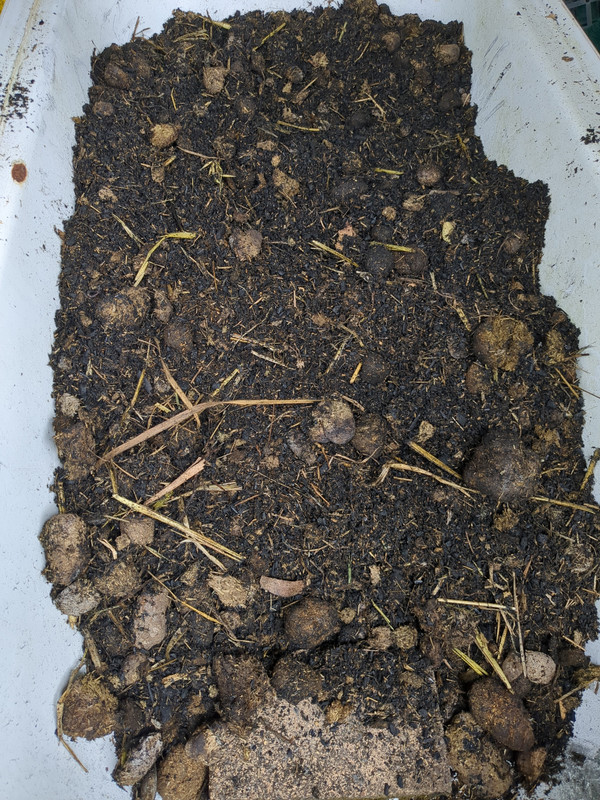Adding of crushed bamboo biochar to a horse manure bedding for a hands-off biological inoculation of the feedstock.
This isn’t my usual worm farm (https://beehaw.org/comment/100268), just one I temporarily put together at a 50:50 ratio of 50L:50L manure:biochar for adding to a structural soil raised garden bed build some time in the future (the longer the better for inoculation purposes).
Mixed in are a small amount of castings from the actual worm farm to accelerate correct bacteria composition and then worms will be added for the processing. It may be fed sporadically, I haven’t decided yet.
Can you explain it like Im 5? I dont understand what’s being inoculated into what here or what the benefits are.
That said this looks like a bad ass setup.
Did you click on the link in the OP that shows the actual worm farm? Horse manure is the bedding and biochar is an additive.
Basically, when you make biochar (the pyrolysis (burning without oxygen) of biomass), it finishes “raw” as straight carbon. If you put this carbon into soil, it would attract “nutrients” and soil life to itself, causing plants to go without for a while, somewhat “hurting” them. This is why “activated charcoal” is used in water and air filters. Biochar functions as a “sponge” and a home for soil life.
To prevent this from happening, you put “inoculated” or “charged” or “activated” biochar into the soil first, biochar that has already attracted microbial life and “nutrients” (ions). To make biochar good for the soil before use, adding it to a compost pile is one of the better ways which is called “co-composting”. While using biochar in compost has some benefits for the compost pile itself, the main reason is to benefit the char, making it ready for application to soil.
Instead of building a compost pile which is a lot of effort and creation of materials in the right ratios, lazy me collects horse manure from a property and adds the char right to it for several months. With the worms which keep the worm farm in a bacterial-rich state, the biochar becomes “charged” with time and no input from me.
As it was added at a 50:50 ratio, when the castings are finished, I will add it to structural soil raised beds which have a ratio of 100:7.5:7.5 gravel:biochar:compost. All I will have to do is mix gravel and 15% of this product together and it’s done.
The structural soil looks like this: https://elk.aus.social/aus.social/@treevan/110293053188000541
ELI15 Biochar:
Biochar is a charcoal-like substance that is produced by burning organic material from agricultural and forestry wastes in a controlled process called pyrolysis[6]. It is a highly porous, stable, carbon-rich material that can be used to improve soil health and crop yield[2]. Here are some reasons why biochar is used:
-
Improving soil fertility: Biochar has a high adsorption and nutrient holding capacity, which can prevent both water and nutrients from leaching while still allowing them to be readily available to plants[1].
-
Reducing water erosion and fertilizer runoff: Biochar’s properties can significantly improve soil’s fertility, making it useful in reducing water erosion and fertilizer runoff[1].
-
Increasing soil carbon: Biochar can increase soil carbon, which facilitates healthier plant life and the growth of soil microbes[3].
-
Facilitating aeration of soils: Straight biochars (non-enriched) are most suited for aeration of soils which are at risk of periodic flooding or soils which are too dense or anaerobic[5].
Biochar can be used in various ways, depending on the specific application. For example, it can be mixed into a field intended for cover crops, used to purify stormwater, filter contaminants, or reduce erosion, or used as a substrate in container nurseries[1][2]. To use biochar in your garden, you can activate it by soaking it in water with compost or other organic matter, and then mix it into the soil[3].
Citations: [1] https://char-grow.com/how-to-use-biochar [2] https://extension.tennessee.edu/publications/Documents/W829.pdf [3] https://rosysoil.com/blogs/news/how-to-use-biochar [4] https://youtube.com/watch?v=LWg1fm6Ss1M [5] https://www.rhs.org.uk/soil-composts-mulches/biochar [6] https://regenerationinternational.org/2018/05/16/what-is-biochar/
This is amazing! Thank you
-




